Analysis of Cultural Safety Position Statement - CDU Wellness
VerifiedAdded on 2023/03/30
|11
|2354
|446
Report
AI Summary
This report presents and analyzes a cultural safety position statement for a healthcare organization, focusing on the National Aboriginal Community Controlled Health (NACCHO) and CDU Wellness Centre. It highlights the importance of cultural safety in addressing health inequities and improving healthcare access for Aboriginal and Torres Strait Islander people. The position statement emphasizes health promotion, collaboration with the Australian government, and increasing the capacity of Aboriginal people in delivering culturally safe care. Effective communication skills are crucial for improving cultural sensitivity and addressing cultural and language differences. The report also discusses the relationship between health literacy and effective communication, external factors influencing culturally safe practice, and potential barriers to implementing the position statement. The analysis concludes by emphasizing the role of the position statement in influencing health outcomes and promoting a welcoming and secure environment for indigenous communities within healthcare settings.
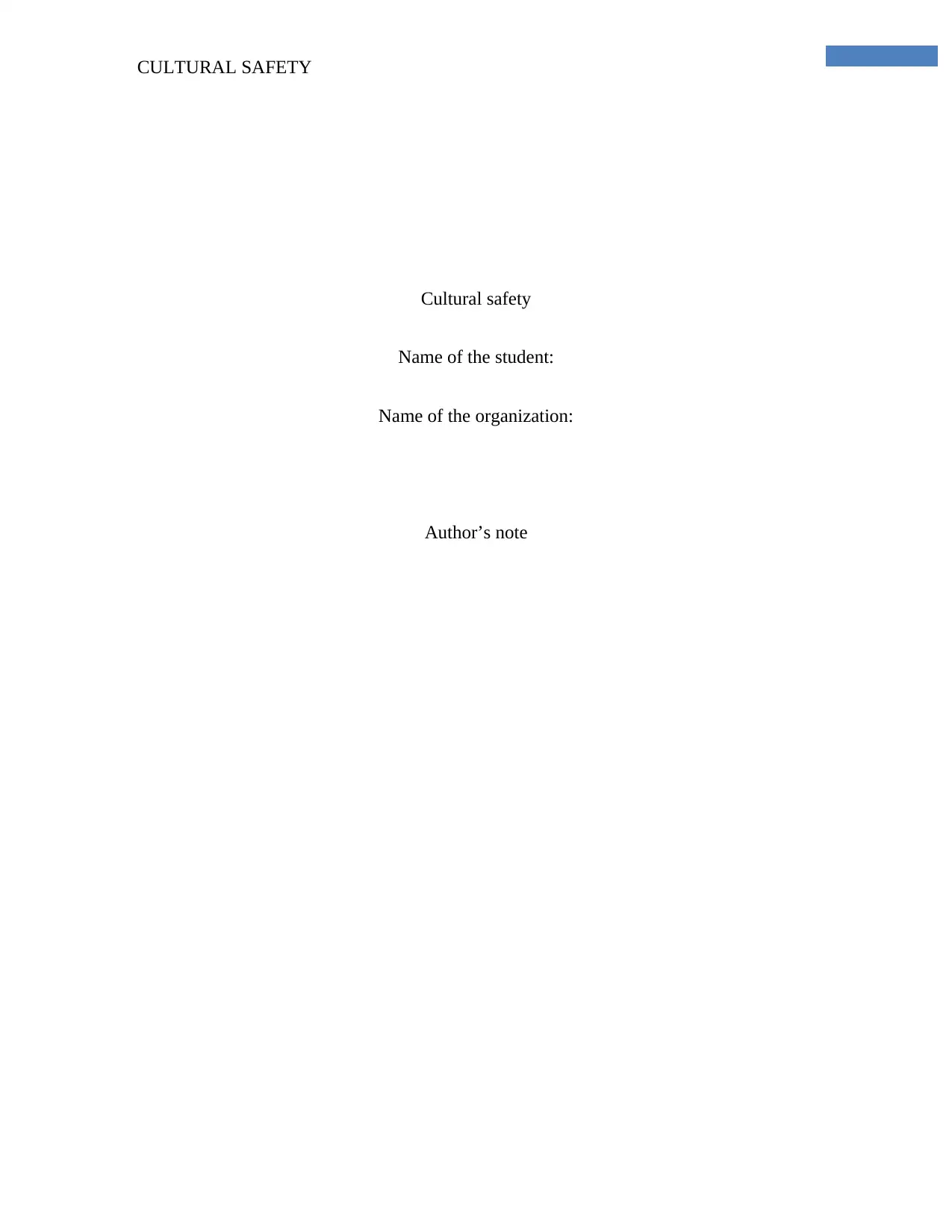
CULTURAL SAFETY
Cultural safety
Name of the student:
Name of the organization:
Author’s note
Cultural safety
Name of the student:
Name of the organization:
Author’s note
Paraphrase This Document
Need a fresh take? Get an instant paraphrase of this document with our AI Paraphraser

CULTURAL SAFETY
Part 1: Position statement for an organization delivering cultural safe health care:
Background of the Organization:
The National Aboriginal Community Controlled Health (NACCHO) is a national peak
organization that works to fulfil the aspirations of the Aboriginal communities. It represents 143
Aboriginal Controlled Health Services (ACCHS) in Australia. The history of making of the
organization starts from 1974 and in 1997, the Federal Government funded NACCHO to
increase skill and capacity of indigenous people in delivering culturally appropriate and safe
care. We aim to deliver holistic care to indigenous groups by providing all support to ACCHS
services in Australia. By monitoring the activities of 143 ACCHS in urban and remote areas of
Australia, we aim to provide wide range of services to increase access to health services for
indigenous group. Our focus is on implementing both multi-functional services as well as small
services. Our multi-specialty services rely on expertise of medical practitioners and the load of
primary care services is taken up by Aboriginal health workers and nurse (NACCHO, 2018).
We are the leading organization working for the cause of Aboriginal people and their
health in Australia. We are in regular communication and interaction with the Australian
Government on implementation of advocacy policy for aboriginal health and promoting quality
of life of indigenous people. Our key strategic direction has been to create a positive and
empowering environment of cultural safety in health services to ensure that responsive and
culturally appropriate care is delivered. We have been working with the goal of establishing
appropriate NACCHO Cultural Safety Training Standards. To further improve in our endeavour
to improve health status of indigenous Australians, our future objective is to establish an
assessment process for achieving the NACCHO standards and creates accessible training activity
Part 1: Position statement for an organization delivering cultural safe health care:
Background of the Organization:
The National Aboriginal Community Controlled Health (NACCHO) is a national peak
organization that works to fulfil the aspirations of the Aboriginal communities. It represents 143
Aboriginal Controlled Health Services (ACCHS) in Australia. The history of making of the
organization starts from 1974 and in 1997, the Federal Government funded NACCHO to
increase skill and capacity of indigenous people in delivering culturally appropriate and safe
care. We aim to deliver holistic care to indigenous groups by providing all support to ACCHS
services in Australia. By monitoring the activities of 143 ACCHS in urban and remote areas of
Australia, we aim to provide wide range of services to increase access to health services for
indigenous group. Our focus is on implementing both multi-functional services as well as small
services. Our multi-specialty services rely on expertise of medical practitioners and the load of
primary care services is taken up by Aboriginal health workers and nurse (NACCHO, 2018).
We are the leading organization working for the cause of Aboriginal people and their
health in Australia. We are in regular communication and interaction with the Australian
Government on implementation of advocacy policy for aboriginal health and promoting quality
of life of indigenous people. Our key strategic direction has been to create a positive and
empowering environment of cultural safety in health services to ensure that responsive and
culturally appropriate care is delivered. We have been working with the goal of establishing
appropriate NACCHO Cultural Safety Training Standards. To further improve in our endeavour
to improve health status of indigenous Australians, our future objective is to establish an
assessment process for achieving the NACCHO standards and creates accessible training activity
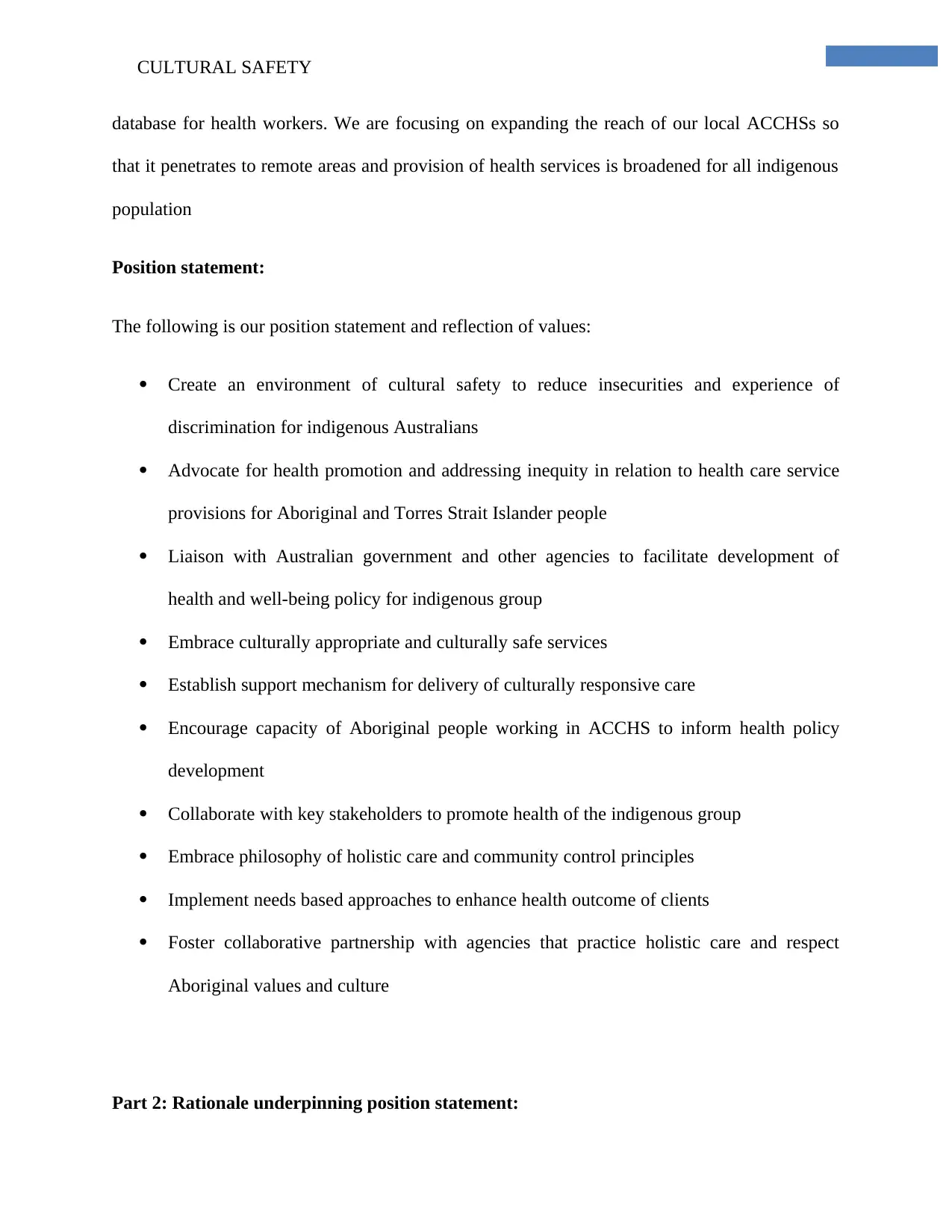
CULTURAL SAFETY
database for health workers. We are focusing on expanding the reach of our local ACCHSs so
that it penetrates to remote areas and provision of health services is broadened for all indigenous
population
Position statement:
The following is our position statement and reflection of values:
Create an environment of cultural safety to reduce insecurities and experience of
discrimination for indigenous Australians
Advocate for health promotion and addressing inequity in relation to health care service
provisions for Aboriginal and Torres Strait Islander people
Liaison with Australian government and other agencies to facilitate development of
health and well-being policy for indigenous group
Embrace culturally appropriate and culturally safe services
Establish support mechanism for delivery of culturally responsive care
Encourage capacity of Aboriginal people working in ACCHS to inform health policy
development
Collaborate with key stakeholders to promote health of the indigenous group
Embrace philosophy of holistic care and community control principles
Implement needs based approaches to enhance health outcome of clients
Foster collaborative partnership with agencies that practice holistic care and respect
Aboriginal values and culture
Part 2: Rationale underpinning position statement:
database for health workers. We are focusing on expanding the reach of our local ACCHSs so
that it penetrates to remote areas and provision of health services is broadened for all indigenous
population
Position statement:
The following is our position statement and reflection of values:
Create an environment of cultural safety to reduce insecurities and experience of
discrimination for indigenous Australians
Advocate for health promotion and addressing inequity in relation to health care service
provisions for Aboriginal and Torres Strait Islander people
Liaison with Australian government and other agencies to facilitate development of
health and well-being policy for indigenous group
Embrace culturally appropriate and culturally safe services
Establish support mechanism for delivery of culturally responsive care
Encourage capacity of Aboriginal people working in ACCHS to inform health policy
development
Collaborate with key stakeholders to promote health of the indigenous group
Embrace philosophy of holistic care and community control principles
Implement needs based approaches to enhance health outcome of clients
Foster collaborative partnership with agencies that practice holistic care and respect
Aboriginal values and culture
Part 2: Rationale underpinning position statement:
⊘ This is a preview!⊘
Do you want full access?
Subscribe today to unlock all pages.

Trusted by 1+ million students worldwide

CULTURAL SAFETY
Significant of having a position statement on providing culturally safe health environment:
The position statement of NACCHO focuses on creating appropriate cultural safety
environment for Aboriginal people in Australia. All the values and actions are reflective of ways
to achieve the strategic goal of cultural safety. It emphasizes on addressing health inequity and
improving provision of services both in urban and rural areas. In health care service, the concept
of cultural safety is a process implemented in response to poor health status and evidence of
disparities and inequalities in health outcome for a vulnerable population group. Cultural safety
principles aims to address inequity in distribution of service and increasing provisions to deliver
service as per cultural expectations and values of the target group (). NACCHO emphasize on
promoting cultural safety across all ACCHS. This position statement has been prioritized
because of widespread report of disparities in health outcome between indigenous and non-
indigenous group. Durey and Thompson (2012) gives the evidence that indigenous people have
worse health outcome than rest of the population and exposure to poverty and disadvantage
increases morbidity and mortality rate and low life expectancy for the group.
The position statement mentions about advocating for health promotion and liasing with
Australian government to develop appropriate policy for culturally appropriate care. The
rationale for this position statement is the evidence of inequitable health care access for
Aboriginal and Torres Strait Islanders because of cultural barriers in care. Li (2017) argues that
health equity demands fairness in providing health care services to diverse population group.
However, cultural differences and lack of cultural training for health care professionals in
Australia result in high rate of infant death, cardiovascular diseases, diabetes and diagnosis of
infectious disease like HIV/AIDS. Hence, collaboration with Australian government is crucial in
showing gaps in current service provision and getting appropriate support to extend wider
Significant of having a position statement on providing culturally safe health environment:
The position statement of NACCHO focuses on creating appropriate cultural safety
environment for Aboriginal people in Australia. All the values and actions are reflective of ways
to achieve the strategic goal of cultural safety. It emphasizes on addressing health inequity and
improving provision of services both in urban and rural areas. In health care service, the concept
of cultural safety is a process implemented in response to poor health status and evidence of
disparities and inequalities in health outcome for a vulnerable population group. Cultural safety
principles aims to address inequity in distribution of service and increasing provisions to deliver
service as per cultural expectations and values of the target group (). NACCHO emphasize on
promoting cultural safety across all ACCHS. This position statement has been prioritized
because of widespread report of disparities in health outcome between indigenous and non-
indigenous group. Durey and Thompson (2012) gives the evidence that indigenous people have
worse health outcome than rest of the population and exposure to poverty and disadvantage
increases morbidity and mortality rate and low life expectancy for the group.
The position statement mentions about advocating for health promotion and liasing with
Australian government to develop appropriate policy for culturally appropriate care. The
rationale for this position statement is the evidence of inequitable health care access for
Aboriginal and Torres Strait Islanders because of cultural barriers in care. Li (2017) argues that
health equity demands fairness in providing health care services to diverse population group.
However, cultural differences and lack of cultural training for health care professionals in
Australia result in high rate of infant death, cardiovascular diseases, diabetes and diagnosis of
infectious disease like HIV/AIDS. Hence, collaboration with Australian government is crucial in
showing gaps in current service provision and getting appropriate support to extend wider
Paraphrase This Document
Need a fresh take? Get an instant paraphrase of this document with our AI Paraphraser
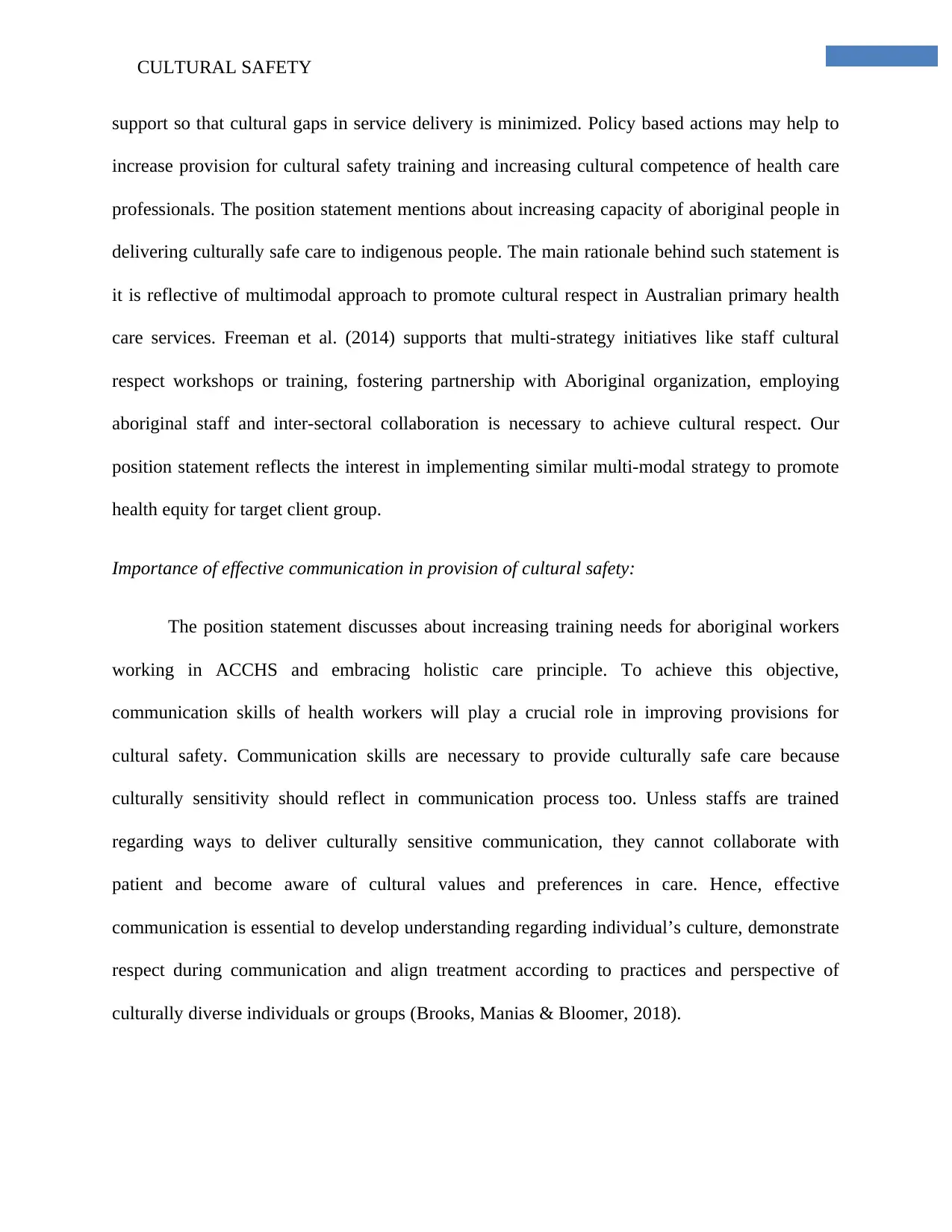
CULTURAL SAFETY
support so that cultural gaps in service delivery is minimized. Policy based actions may help to
increase provision for cultural safety training and increasing cultural competence of health care
professionals. The position statement mentions about increasing capacity of aboriginal people in
delivering culturally safe care to indigenous people. The main rationale behind such statement is
it is reflective of multimodal approach to promote cultural respect in Australian primary health
care services. Freeman et al. (2014) supports that multi-strategy initiatives like staff cultural
respect workshops or training, fostering partnership with Aboriginal organization, employing
aboriginal staff and inter-sectoral collaboration is necessary to achieve cultural respect. Our
position statement reflects the interest in implementing similar multi-modal strategy to promote
health equity for target client group.
Importance of effective communication in provision of cultural safety:
The position statement discusses about increasing training needs for aboriginal workers
working in ACCHS and embracing holistic care principle. To achieve this objective,
communication skills of health workers will play a crucial role in improving provisions for
cultural safety. Communication skills are necessary to provide culturally safe care because
culturally sensitivity should reflect in communication process too. Unless staffs are trained
regarding ways to deliver culturally sensitive communication, they cannot collaborate with
patient and become aware of cultural values and preferences in care. Hence, effective
communication is essential to develop understanding regarding individual’s culture, demonstrate
respect during communication and align treatment according to practices and perspective of
culturally diverse individuals or groups (Brooks, Manias & Bloomer, 2018).
support so that cultural gaps in service delivery is minimized. Policy based actions may help to
increase provision for cultural safety training and increasing cultural competence of health care
professionals. The position statement mentions about increasing capacity of aboriginal people in
delivering culturally safe care to indigenous people. The main rationale behind such statement is
it is reflective of multimodal approach to promote cultural respect in Australian primary health
care services. Freeman et al. (2014) supports that multi-strategy initiatives like staff cultural
respect workshops or training, fostering partnership with Aboriginal organization, employing
aboriginal staff and inter-sectoral collaboration is necessary to achieve cultural respect. Our
position statement reflects the interest in implementing similar multi-modal strategy to promote
health equity for target client group.
Importance of effective communication in provision of cultural safety:
The position statement discusses about increasing training needs for aboriginal workers
working in ACCHS and embracing holistic care principle. To achieve this objective,
communication skills of health workers will play a crucial role in improving provisions for
cultural safety. Communication skills are necessary to provide culturally safe care because
culturally sensitivity should reflect in communication process too. Unless staffs are trained
regarding ways to deliver culturally sensitive communication, they cannot collaborate with
patient and become aware of cultural values and preferences in care. Hence, effective
communication is essential to develop understanding regarding individual’s culture, demonstrate
respect during communication and align treatment according to practices and perspective of
culturally diverse individuals or groups (Brooks, Manias & Bloomer, 2018).
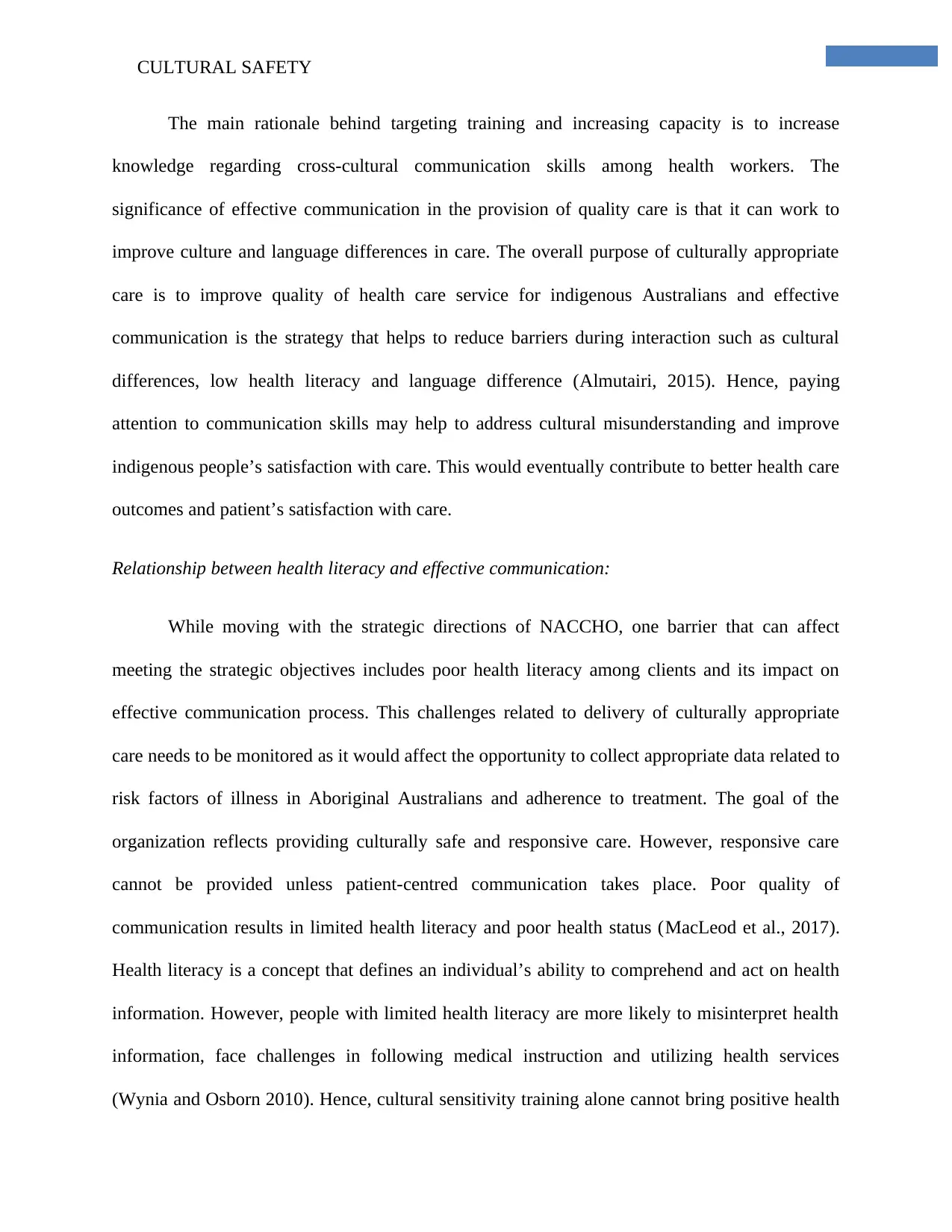
CULTURAL SAFETY
The main rationale behind targeting training and increasing capacity is to increase
knowledge regarding cross-cultural communication skills among health workers. The
significance of effective communication in the provision of quality care is that it can work to
improve culture and language differences in care. The overall purpose of culturally appropriate
care is to improve quality of health care service for indigenous Australians and effective
communication is the strategy that helps to reduce barriers during interaction such as cultural
differences, low health literacy and language difference (Almutairi, 2015). Hence, paying
attention to communication skills may help to address cultural misunderstanding and improve
indigenous people’s satisfaction with care. This would eventually contribute to better health care
outcomes and patient’s satisfaction with care.
Relationship between health literacy and effective communication:
While moving with the strategic directions of NACCHO, one barrier that can affect
meeting the strategic objectives includes poor health literacy among clients and its impact on
effective communication process. This challenges related to delivery of culturally appropriate
care needs to be monitored as it would affect the opportunity to collect appropriate data related to
risk factors of illness in Aboriginal Australians and adherence to treatment. The goal of the
organization reflects providing culturally safe and responsive care. However, responsive care
cannot be provided unless patient-centred communication takes place. Poor quality of
communication results in limited health literacy and poor health status (MacLeod et al., 2017).
Health literacy is a concept that defines an individual’s ability to comprehend and act on health
information. However, people with limited health literacy are more likely to misinterpret health
information, face challenges in following medical instruction and utilizing health services
(Wynia and Osborn 2010). Hence, cultural sensitivity training alone cannot bring positive health
The main rationale behind targeting training and increasing capacity is to increase
knowledge regarding cross-cultural communication skills among health workers. The
significance of effective communication in the provision of quality care is that it can work to
improve culture and language differences in care. The overall purpose of culturally appropriate
care is to improve quality of health care service for indigenous Australians and effective
communication is the strategy that helps to reduce barriers during interaction such as cultural
differences, low health literacy and language difference (Almutairi, 2015). Hence, paying
attention to communication skills may help to address cultural misunderstanding and improve
indigenous people’s satisfaction with care. This would eventually contribute to better health care
outcomes and patient’s satisfaction with care.
Relationship between health literacy and effective communication:
While moving with the strategic directions of NACCHO, one barrier that can affect
meeting the strategic objectives includes poor health literacy among clients and its impact on
effective communication process. This challenges related to delivery of culturally appropriate
care needs to be monitored as it would affect the opportunity to collect appropriate data related to
risk factors of illness in Aboriginal Australians and adherence to treatment. The goal of the
organization reflects providing culturally safe and responsive care. However, responsive care
cannot be provided unless patient-centred communication takes place. Poor quality of
communication results in limited health literacy and poor health status (MacLeod et al., 2017).
Health literacy is a concept that defines an individual’s ability to comprehend and act on health
information. However, people with limited health literacy are more likely to misinterpret health
information, face challenges in following medical instruction and utilizing health services
(Wynia and Osborn 2010). Hence, cultural sensitivity training alone cannot bring positive health
⊘ This is a preview!⊘
Do you want full access?
Subscribe today to unlock all pages.

Trusted by 1+ million students worldwide
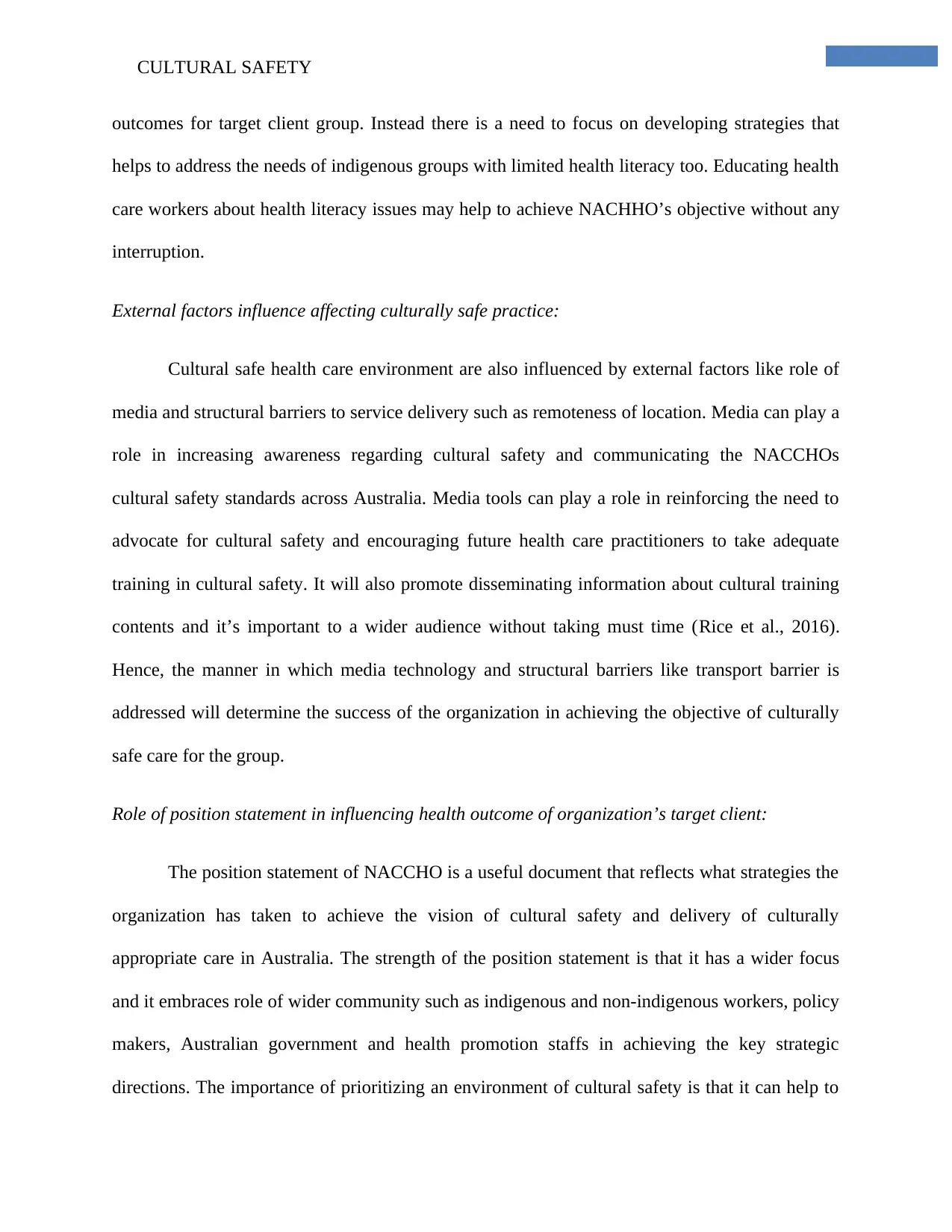
CULTURAL SAFETY
outcomes for target client group. Instead there is a need to focus on developing strategies that
helps to address the needs of indigenous groups with limited health literacy too. Educating health
care workers about health literacy issues may help to achieve NACHHO’s objective without any
interruption.
External factors influence affecting culturally safe practice:
Cultural safe health care environment are also influenced by external factors like role of
media and structural barriers to service delivery such as remoteness of location. Media can play a
role in increasing awareness regarding cultural safety and communicating the NACCHOs
cultural safety standards across Australia. Media tools can play a role in reinforcing the need to
advocate for cultural safety and encouraging future health care practitioners to take adequate
training in cultural safety. It will also promote disseminating information about cultural training
contents and it’s important to a wider audience without taking must time (Rice et al., 2016).
Hence, the manner in which media technology and structural barriers like transport barrier is
addressed will determine the success of the organization in achieving the objective of culturally
safe care for the group.
Role of position statement in influencing health outcome of organization’s target client:
The position statement of NACCHO is a useful document that reflects what strategies the
organization has taken to achieve the vision of cultural safety and delivery of culturally
appropriate care in Australia. The strength of the position statement is that it has a wider focus
and it embraces role of wider community such as indigenous and non-indigenous workers, policy
makers, Australian government and health promotion staffs in achieving the key strategic
directions. The importance of prioritizing an environment of cultural safety is that it can help to
outcomes for target client group. Instead there is a need to focus on developing strategies that
helps to address the needs of indigenous groups with limited health literacy too. Educating health
care workers about health literacy issues may help to achieve NACHHO’s objective without any
interruption.
External factors influence affecting culturally safe practice:
Cultural safe health care environment are also influenced by external factors like role of
media and structural barriers to service delivery such as remoteness of location. Media can play a
role in increasing awareness regarding cultural safety and communicating the NACCHOs
cultural safety standards across Australia. Media tools can play a role in reinforcing the need to
advocate for cultural safety and encouraging future health care practitioners to take adequate
training in cultural safety. It will also promote disseminating information about cultural training
contents and it’s important to a wider audience without taking must time (Rice et al., 2016).
Hence, the manner in which media technology and structural barriers like transport barrier is
addressed will determine the success of the organization in achieving the objective of culturally
safe care for the group.
Role of position statement in influencing health outcome of organization’s target client:
The position statement of NACCHO is a useful document that reflects what strategies the
organization has taken to achieve the vision of cultural safety and delivery of culturally
appropriate care in Australia. The strength of the position statement is that it has a wider focus
and it embraces role of wider community such as indigenous and non-indigenous workers, policy
makers, Australian government and health promotion staffs in achieving the key strategic
directions. The importance of prioritizing an environment of cultural safety is that it can help to
Paraphrase This Document
Need a fresh take? Get an instant paraphrase of this document with our AI Paraphraser

CULTURAL SAFETY
address cultural barriers that lead to poor access of health care services for indigenous
Australians (Gray & Oprescu, 2016). This is said because lack of cultural sensitivity and
experience of disrespect and discrimination are some of the cause behind aboriginal people to
stay away from health care services and experience disparities in health outcome. Hence, when
an environment for cultural safety is created, it will promote developing welcoming environment
for the target group where they will feel protected and free from any insecurities. This clarified
how the position statement is effective in improving health outcome for the target client group
that NACHHO has targeted.
Another strength of the position statement is that it focus on collaboration with Australain
government and other interlinked agencies to promote health of indigenous Australians. The
significance of taking strategy is that it is alignment with current demands of health promotion.
The strategy is in congruence with the Ottawa Charter Action areas of building a health public
policy (World Health Organization, 2019). The Ottawa Charter mentions about paying attention
to joint action to foster health equity. This involved identifying obstacles in service and taking
steps to facilitation implementation of policies that led to enactment of appropriate legislations
and organizational change. Hence, the position statement of collaborating with Australian
government to implement health care policy for Indigenous Australians reflect that the
organization has done all the ground work to identify barriers that lead to health equity. By
highlighting data related to lack of culturally sensitivity and cultural barriers in health care, the
organization has the potential to promote policy related changes. The advantage of targeting
policy change is that it creates appropriate supportive environment to ensure that all supportive
mechanisms exist to achieve the key objectives in care (Mackean et al., 2019).
Barriers to implementing the position statement:
address cultural barriers that lead to poor access of health care services for indigenous
Australians (Gray & Oprescu, 2016). This is said because lack of cultural sensitivity and
experience of disrespect and discrimination are some of the cause behind aboriginal people to
stay away from health care services and experience disparities in health outcome. Hence, when
an environment for cultural safety is created, it will promote developing welcoming environment
for the target group where they will feel protected and free from any insecurities. This clarified
how the position statement is effective in improving health outcome for the target client group
that NACHHO has targeted.
Another strength of the position statement is that it focus on collaboration with Australain
government and other interlinked agencies to promote health of indigenous Australians. The
significance of taking strategy is that it is alignment with current demands of health promotion.
The strategy is in congruence with the Ottawa Charter Action areas of building a health public
policy (World Health Organization, 2019). The Ottawa Charter mentions about paying attention
to joint action to foster health equity. This involved identifying obstacles in service and taking
steps to facilitation implementation of policies that led to enactment of appropriate legislations
and organizational change. Hence, the position statement of collaborating with Australian
government to implement health care policy for Indigenous Australians reflect that the
organization has done all the ground work to identify barriers that lead to health equity. By
highlighting data related to lack of culturally sensitivity and cultural barriers in health care, the
organization has the potential to promote policy related changes. The advantage of targeting
policy change is that it creates appropriate supportive environment to ensure that all supportive
mechanisms exist to achieve the key objectives in care (Mackean et al., 2019).
Barriers to implementing the position statement:

CULTURAL SAFETY
The strength of the position statement is that it has adapted useful evidence based
strategies that would help to create an environment of health safety. NACCHO has adapted
multi-modal strategy to promote culturally appropriate. This will help to address gaps that may
exist in different point of care. However, one barrier that may affect implementation of the
position statement is lack of appropriate staff to achieve the vision. This is said because the
organization aims to expand health service to remotes areas. However, targeting service
expansion as well as cultural safety will require recruitment of large number of aboriginal and
non-aboriginal workers. Keeping up with the human resource demand will be a challenge.
The strength of the position statement is that it has adapted useful evidence based
strategies that would help to create an environment of health safety. NACCHO has adapted
multi-modal strategy to promote culturally appropriate. This will help to address gaps that may
exist in different point of care. However, one barrier that may affect implementation of the
position statement is lack of appropriate staff to achieve the vision. This is said because the
organization aims to expand health service to remotes areas. However, targeting service
expansion as well as cultural safety will require recruitment of large number of aboriginal and
non-aboriginal workers. Keeping up with the human resource demand will be a challenge.
⊘ This is a preview!⊘
Do you want full access?
Subscribe today to unlock all pages.

Trusted by 1+ million students worldwide
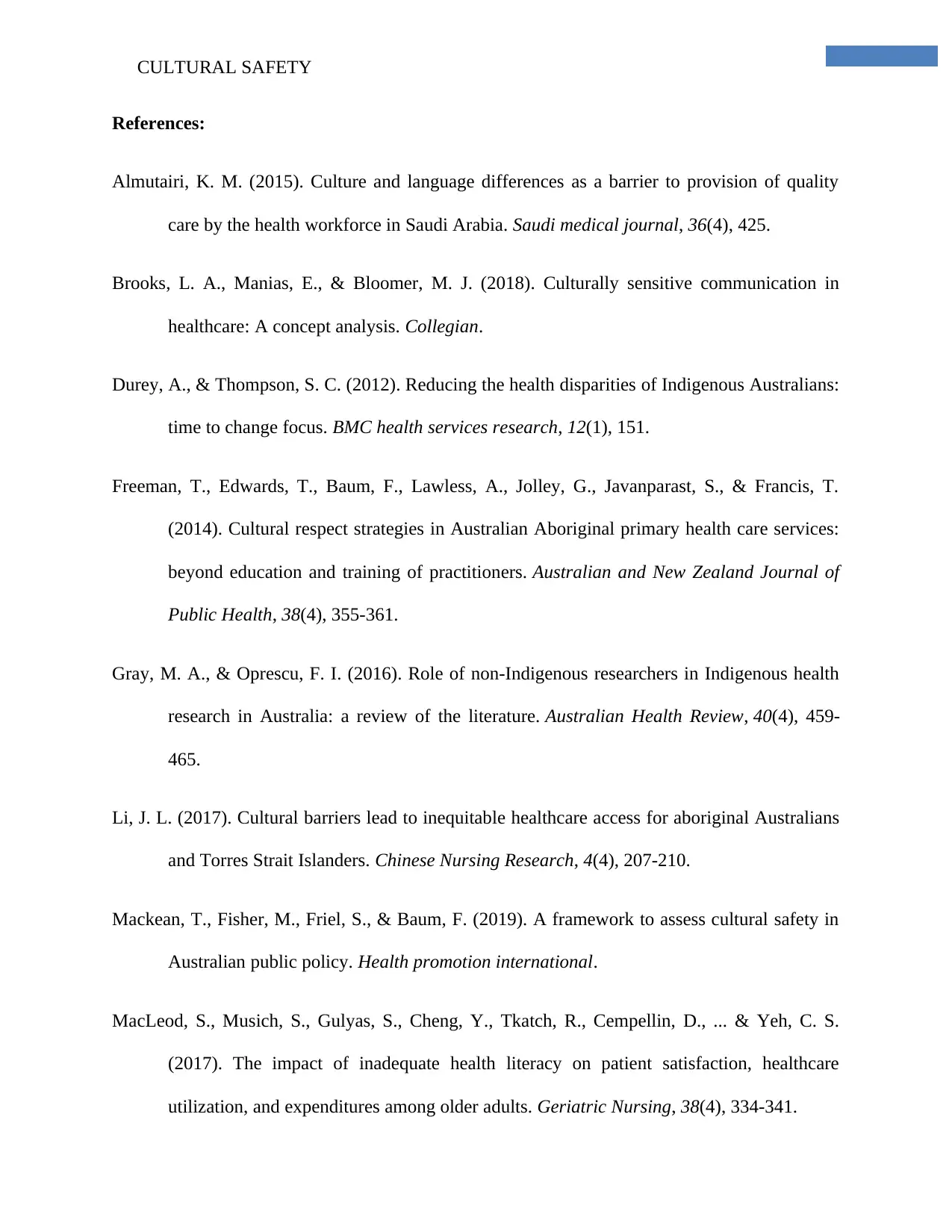
CULTURAL SAFETY
References:
Almutairi, K. M. (2015). Culture and language differences as a barrier to provision of quality
care by the health workforce in Saudi Arabia. Saudi medical journal, 36(4), 425.
Brooks, L. A., Manias, E., & Bloomer, M. J. (2018). Culturally sensitive communication in
healthcare: A concept analysis. Collegian.
Durey, A., & Thompson, S. C. (2012). Reducing the health disparities of Indigenous Australians:
time to change focus. BMC health services research, 12(1), 151.
Freeman, T., Edwards, T., Baum, F., Lawless, A., Jolley, G., Javanparast, S., & Francis, T.
(2014). Cultural respect strategies in Australian Aboriginal primary health care services:
beyond education and training of practitioners. Australian and New Zealand Journal of
Public Health, 38(4), 355-361.
Gray, M. A., & Oprescu, F. I. (2016). Role of non-Indigenous researchers in Indigenous health
research in Australia: a review of the literature. Australian Health Review, 40(4), 459-
465.
Li, J. L. (2017). Cultural barriers lead to inequitable healthcare access for aboriginal Australians
and Torres Strait Islanders. Chinese Nursing Research, 4(4), 207-210.
Mackean, T., Fisher, M., Friel, S., & Baum, F. (2019). A framework to assess cultural safety in
Australian public policy. Health promotion international.
MacLeod, S., Musich, S., Gulyas, S., Cheng, Y., Tkatch, R., Cempellin, D., ... & Yeh, C. S.
(2017). The impact of inadequate health literacy on patient satisfaction, healthcare
utilization, and expenditures among older adults. Geriatric Nursing, 38(4), 334-341.
References:
Almutairi, K. M. (2015). Culture and language differences as a barrier to provision of quality
care by the health workforce in Saudi Arabia. Saudi medical journal, 36(4), 425.
Brooks, L. A., Manias, E., & Bloomer, M. J. (2018). Culturally sensitive communication in
healthcare: A concept analysis. Collegian.
Durey, A., & Thompson, S. C. (2012). Reducing the health disparities of Indigenous Australians:
time to change focus. BMC health services research, 12(1), 151.
Freeman, T., Edwards, T., Baum, F., Lawless, A., Jolley, G., Javanparast, S., & Francis, T.
(2014). Cultural respect strategies in Australian Aboriginal primary health care services:
beyond education and training of practitioners. Australian and New Zealand Journal of
Public Health, 38(4), 355-361.
Gray, M. A., & Oprescu, F. I. (2016). Role of non-Indigenous researchers in Indigenous health
research in Australia: a review of the literature. Australian Health Review, 40(4), 459-
465.
Li, J. L. (2017). Cultural barriers lead to inequitable healthcare access for aboriginal Australians
and Torres Strait Islanders. Chinese Nursing Research, 4(4), 207-210.
Mackean, T., Fisher, M., Friel, S., & Baum, F. (2019). A framework to assess cultural safety in
Australian public policy. Health promotion international.
MacLeod, S., Musich, S., Gulyas, S., Cheng, Y., Tkatch, R., Cempellin, D., ... & Yeh, C. S.
(2017). The impact of inadequate health literacy on patient satisfaction, healthcare
utilization, and expenditures among older adults. Geriatric Nursing, 38(4), 334-341.
Paraphrase This Document
Need a fresh take? Get an instant paraphrase of this document with our AI Paraphraser
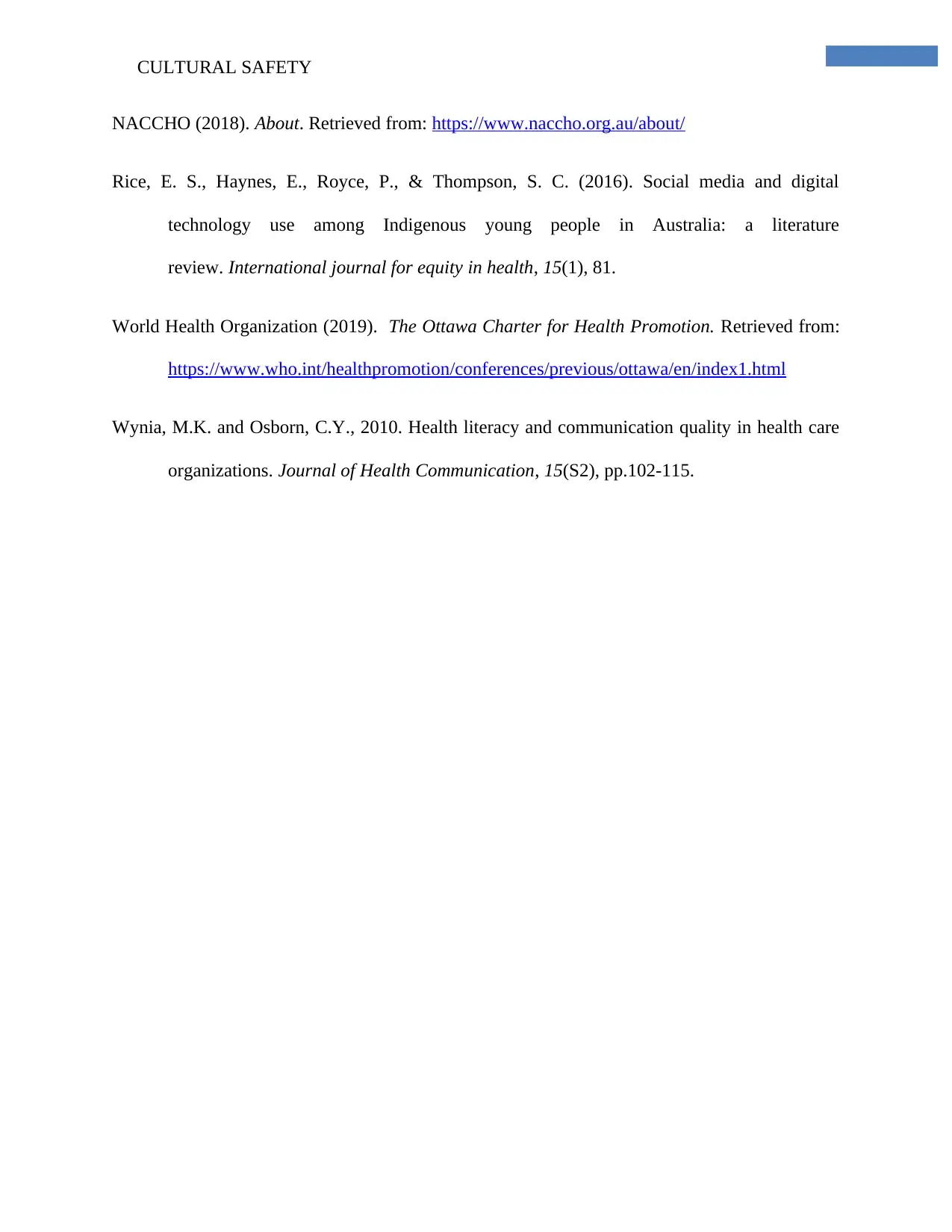
CULTURAL SAFETY
NACCHO (2018). About. Retrieved from: https://www.naccho.org.au/about/
Rice, E. S., Haynes, E., Royce, P., & Thompson, S. C. (2016). Social media and digital
technology use among Indigenous young people in Australia: a literature
review. International journal for equity in health, 15(1), 81.
World Health Organization (2019). The Ottawa Charter for Health Promotion. Retrieved from:
https://www.who.int/healthpromotion/conferences/previous/ottawa/en/index1.html
Wynia, M.K. and Osborn, C.Y., 2010. Health literacy and communication quality in health care
organizations. Journal of Health Communication, 15(S2), pp.102-115.
NACCHO (2018). About. Retrieved from: https://www.naccho.org.au/about/
Rice, E. S., Haynes, E., Royce, P., & Thompson, S. C. (2016). Social media and digital
technology use among Indigenous young people in Australia: a literature
review. International journal for equity in health, 15(1), 81.
World Health Organization (2019). The Ottawa Charter for Health Promotion. Retrieved from:
https://www.who.int/healthpromotion/conferences/previous/ottawa/en/index1.html
Wynia, M.K. and Osborn, C.Y., 2010. Health literacy and communication quality in health care
organizations. Journal of Health Communication, 15(S2), pp.102-115.
1 out of 11
Related Documents
Your All-in-One AI-Powered Toolkit for Academic Success.
+13062052269
info@desklib.com
Available 24*7 on WhatsApp / Email
![[object Object]](/_next/static/media/star-bottom.7253800d.svg)
Unlock your academic potential
Copyright © 2020–2025 A2Z Services. All Rights Reserved. Developed and managed by ZUCOL.





